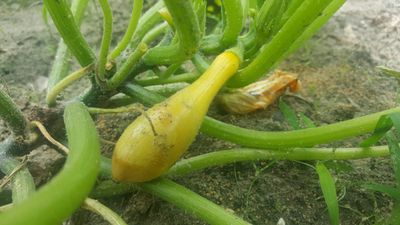Causes for Squash End Rot
The causes for squash end rot are simple. Squash blossom end rot happens due to a calcium deficiency. Calcium helps a plant create a stable structure. If a plant gets too little calcium while the fruit is developing, there isn’t enough to sufficiently build the cells on the fruit. In particular, the bottom of the fruit, which grows the fastest, doesn’t get enough calcium. As the fruit gets larger, the cells begin to collapse, starting with the weakest cells at the bottom. At the location of the squash blossom, rot sets in and a black indentation appears. While the causes for squash end rot will not make the squash dangerous to eat, the lack of calcium frequently causes the fruit to mature too early and the squash will not taste very good.
Blossom End Rot Treatment
There are a few things you can try for blossom end rot treatment. Keep in mind that all of these treatments must be done before squash blossom end rot appears. Once the fruit is affected, you cannot correct it. Water evenly – If the plant goes through drastic changes in the amount of water it gets, it may not be able to take up the calcium it needs at the crucial time when the fruit is being formed. Water evenly, not too much or too little. Add the right kind of fertilizer – Add a low nitrogen fertilizer to the soil before you plant. Too much nitrogen will cause an imbalance of growth between the roots and the leaves. If the leaves grow too fast, the plant does not have enough roots to take up calcium the squash fruit will need. Add lime – The soil pH must be between 6.0 and 6.5 for optimal calcium uptake. Use lime to balance your soil’s pH if it is too low. Add gypsum – Gypsum will help add calcium to the soil and will make that nutrient more readily available. Remove the fruit and fix the problem – If squash blossom end rot appears, remove the affected fruit and use a calcium-rich foliar spray on the plant. This will ensure that the next round of squash the plant grows will have sufficient calcium to grow correctly. The causes for squash end rot are very simple and blossom end rot treatment is easy enough when you know the source of the problem.
